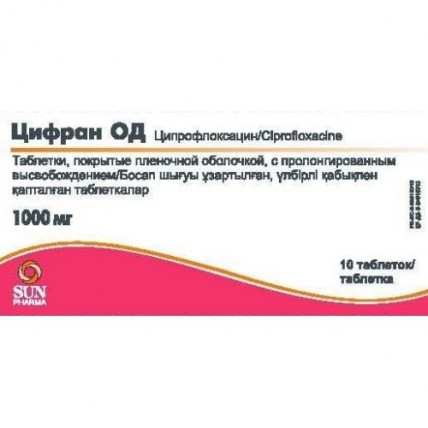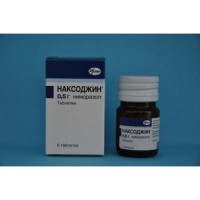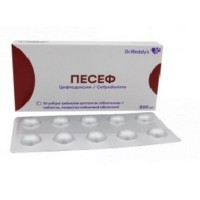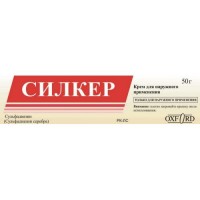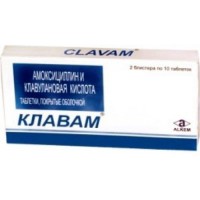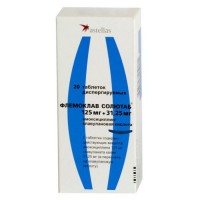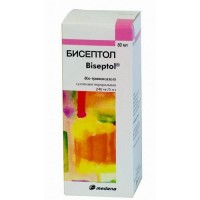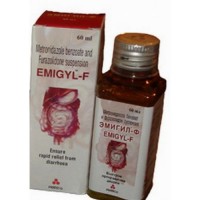TSifran 1000 mg OD tablets coated film 10s
- $16.50
The instruction for medical use of Tsifran AUDE Torgovoye medicine a name Tsifran of AUDE Mejdounarodnoye the unlicensed name Ciprofloxacin Dosage Form of the Tablet, film coated, with the prolonged release Structure One tablet contains active agent – ciprofloxacin of 1000 mg excipients: intragranulit: sodium alginat, a gipromelloza, sodium bicarbonate, krospovidon, magnesium stearate, ekstragranulit: magnesium the stearate, talc purified silicon dioxide colloidal anhydrous, a cover: opadray 31B58910 white (a gipromelloza, lactoses monohydrate, the titan dioxide (E171), a macrogoal 400), a gipromelloza, the talc purified, Opacode S-1-17823 ink (Black): shellac glossy, isopropyl alcohol, gland (III) oxide black (E172), butyl alcohol, propylene glycol, 28% ammonia solution. The description of the Tablet of an oval form, film coated from white till almost white color, with the inscription Cifran OD 1000 MG food paint on one party. Length 21.2 ± 0.1 mm, width 10.6 ± 0.1 mm, thickness 7.6 ± 0.3 mm. Pharmacotherapeutic group Antibacterial drugs for system use. Antimicrobial drugs – derivatives of a hinolon. Ftorkhinolona. Ciprofloxacin. The ATX J01MA02 code the Pharmacological Pharmacokinetics Ciprofloxacin properties of a tablet with the prolonged action are developed for release of drug at lower speed in comparison with tablets of fast release. The pharmacokinetic profile of ciprofloxacin of a tablet with the prolonged action of 1000 mg is comparable with a profile of 500 mg of ciprofloxacin of a tablet with fast release two times a day, in terms of comparable AUC throughout the 24-hour period of dosing once a day. Absorption After oral administration ciprofloxacin is quickly soaked up mainly in a small intestine. The maximum concentration of ciprofloxacin in blood serum is reached in 1-2 h. The bioavailability is about 70-80%. Values of the maximum concentration under a curve concentration - time (AUC) increase in blood plasma (Cmax) and the area in proportion to a dose. Distribution Communication of ciprofloxacin with proteins of blood plasma makes 20-30%, active agent is present at blood plasma mainly in not ionized form. Ciprofloxacin is freely distributed in fabrics and liquids of an organism. Distribution volume in an organism is 2-3 l/kg. Concentration of ciprofloxacin in fabrics considerably exceeds concentration in blood serum. Metabolism of Biotransformiruyetsya in a liver. In blood four metabolites of ciprofloxacin in small concentration can be found: diethylciprofloxacin (Ml), sulfociprofloxacin (M2), oxociprofloxacin (MZ), formylciprofloxacin (M4), three of which (M1-MZ) show the antibacterial activity of in vitro comparable to antibacterial activity of Acidum nalidixicum. The antibacterial activity of in vitro of a metabolite of M4 which is present at smaller quantity corresponds to activity of norfloxacin more. Removal Ciprofloxacin is brought out of an organism mainly by kidneys by glomerular filtration and canalicular secretion, insignificant quantity - through digestive tract. Removal happens to urine within 24 hours after administration of drug. From 1 to 2% of the accepted dose are removed with bile in the form of metabolites, about 20-35% of drug are removed with excrements within 5 days after reception. Elimination half-life at patients with normal function of kidneys makes about 7 hours of serum. Elderly Pharmacokinetic analyses of oral tablets with immediate release (single dose) and ciprofloxacin forms for intravenous administration (single and repeated doses) show that concentration of ciprofloxacin in plasma are higher at elderly people (65 years are more senior) in comparison with young adults. Cmax raises from 16% to 40%, and average AUC increases approximately by 30% that can be partially caused by decrease in renal clearance in elderly people, at least. Elimination half-life only a little longer at elderly people (~ 20%). These distinctions are not clinically significant. The renal failure At patients with reduced function of kidneys, elimination half-life of ciprofloxacin can be extended. Correction of a dose is not required to patients with uncomplicated infections of the urinary tract receiving 500 mg of a dosage form of ciprofloxacin with the prolonged action. For the complicated infections of urinary tract and acute uncomplicated pyelonephritis where the dose of 1000 mg is applied, it is necessary to reduce a dosage of a dosage form of ciprofloxacin with the prolonged action to 500 mg of 1 times a day (the clearance of creatinine is lower than 30 ml/min.). A liver failure At a research of patients with stable chronic cirrhosis significant changes in ciprofloxacin pharmacokinetics were not observed. At the same time the ciprofloxacin kinetics at patients with an acute liver failure is insufficiently revealed. The pharmacodynamics Ciprofloxacin represents synthetic antibacterial drug of a broad spectrum of activity from group of ftorkhinolon. The action mechanism Ciprofloxacin has activity of in vitro concerning a wide range of gram-negative and gram-positive microorganisms. Bactericidal effect of ciprofloxacin is carried out by means of inhibition of bacterial topoisomerases II of type (topoisomerase II (DNK-giraza) and topoisomerase IV) which are necessary for replication, a transcription, a reparation and a recombination of bacterial DNA. Resistance mechanisms the Resistance of in vitro to ciprofloxacin is often caused by dot mutations of bacterial topoisomerases and DNK-girazy and develops slowly by means of multistage mutations. Single mutations can lead rather to decrease in sensitivity, than ment of clinical stability, however multiple mutations generally lead ment of clinical resistance to ciprofloxacin and to cross resistance to drugs of a hinolonovy row. Resistance to ciprofloxacin, as well as. to many other antibiotics, it can be formed as a result of decrease in permeability of a cell wall of bacteria (as it often occurs in case of Pseudomonas aeruginosa) and/or activation of removal from a microbic cell (efflux). It is reported about development of the resistance caused by the coding Qnr gene localized on plasmids. Resistance mechanisms which lead to an inactivation of penicillin of cephalosporins, aminoglycosides, macroleads and tetracyclines probably do not break antibacterial activity of ciprofloxacin. The microorganisms resistant to these drugs can be sensitive to ciprofloxacin. The Minimum Bactericidal, Concentration (MB,C) usually does not exceed the minimum inhibiting concentration (MIC) more than twice. Cross resistance. The cross resistance between ciprofloxacin and antimicrobial drugs of other classes is not noted. Ciprofloxacin shows activity concerning the majority of strains of the following bacteria both in the conditions of in vitro, and in clinical practice of treatment of infections. Aerobic gram-positive microorganisms: Bacillus anthracis, Staphylococcus aureus (Methicillinum - sensitive), Staphylococcus saprophyticus, Streptococcus spp. Aerobic gram-negative microorganisms: Aeromonas spp., Moraxella catarrhalis, Brucella spp., Neisseria meningitidis, Citrobacter koseri, Pasteurella spp., Francisella tularensi, Salmonella spp., Haemophilus ducreyi, Shigella spp., Haemophilius influenzae, Vibrio spp., Legionella spp., Yersinia pestis. Anaerobic microorganisms: Mobiluncus spp. Other microorganisms: Chlamydia trachomatis, Chlamydia pneumoniae, Mycoplasma hominis, Mycoplasma pneumoniae. The varying sensitivity degree to ciprofloxacin for the following microorganisms was shown: Acinetobacter baumann, Burkholderia cepacia, Campylobacter spp., Citrobacter freundii, Enterococcus faecalis, Enterobacter aerogenes, Enterobacter cloacae, Escherichia coli, Klebsiella pneumoniae, Klebsiella oxytoca, Morganella morganii, Neisseria gonorrhoeae, Proteus mirabilis, Proteus vulgaris, Providencia spp., Pseudomonas aeruginosa, Pseudomonas fluorescens, Serratia marcescens, Streptococcus pneumoniae, Peptostreptococcus spp., Propionibacterium acnes. It is considered that natural resistance to ciprofloxacin Staphylococcus aureus (Methicillinum - resistant), Stenotrophomonas maltophilia, Actinomyces spp., Enteroccus faecium, Listeria monocytogenes, Mycoplasma genitalium, Ureaplasma urealitycum, anaerobic microorganisms possess (except for Mobiluncus spp., Peptostreptococus spp., Propionibacterium acnes). Indications the Uncomplicated and complicated infections caused by microorganisms, sensitive to ciprofloxacin. Adults - respiratory infections. It is recommended to appoint ciprofloxacin in pneumonia, the caused Klebsiella spp., Enterobacter spp., Proteus spp., Esherichia coli, Pseudomonas aeruginosa, Haemophilus spp., Moraxella catarrhalis, Legionella spp. and stafilokokkam - infections of a middle ear (average otitis), adnexal bosoms (sinusitis), especially if these infections are caused by gram-negative microorganisms, including Pseudomonas aeruginosa or staphylococcus, - infections of eyes - infections of kidneys and/or urinary tract - infections of genitals, including an adnexitis, gonorrhea, prostatitis - infections of an abdominal cavity (bacterial infections of digestive tract, biliary tract, peritonitis) - infections of skin and soft tissues - sepsis - infections or prevention of infections in patients with reduced immunity (patients, accepting immunodepressants or patients with a neutropenia) - selection decontamination of intestines in patients with reduced immunity - prevention and treatment of an inhalation anthrax (infection of Bacillus anthracis) - prevention of the invasive infections caused by Neisseria meningitidis. It is necessary to take into account the acting official managements about rules of use of antibacterial agents. Children - treatment of the complications caused by Pseudomonas aeruginosa in children with a mucoviscidosis of easy from 6 to 17 years - prevention and treatment of an inhalation anthrax (infection of Bacillus anthracis) it is necessary to swallow of the Route of administration and doses of the Tablet without chewing, washing down with water. They can be accepted irrespective of meal time. At reception on a hungry stomach, active agent it is soaked up quicker. The pill Tsifran AUDE is taken once a day. The dosage and a course of treatment depend on indications, severity and localization of an infection, susceptibility to ciprofloxacin of a pathogenic microorganism(s), function of kidneys of patients and on clinical and bacteriological performance. Higher doses of ciprofloxacin and joint introduction with other appropriate antibacterial agents can be necessary for treatment of some bacterial infections (e.g. Pseudomonas aeruginosa, Acinetobacter or Staphylococci). Joint introduction with other appropriate antibacterial agents depending on the involved pathogens can be necessary for treatment of some infections (e.g. inflammatory diseases of bodies of a small pelvis, intraabdominal infections, infections at neytropenichesky patients and an infection of bones and joints). Indications the Daily dose in mg the treatment Duration (which is potentially including initial parenteral treatment by ciprofloxacin) of the Lower respiratory tract infection of 1000 mg-1500 of mg of 7 - 14 days of the Upper respiratory tract infection Exacerbation of chronic sinusitis of 1000 mg – 1500 mg of 7 - 14 days Chronic purulent average otitis of 1000 mg - 1500 mg of 7 - 14 days Malignant external otitis of 1500 mg of 28 days up to 3 months of the Infection of urinary tract Uncomplicated cystitis of 500 mg - to 1000 mg are 3 days At women of premenopausal age 500 mg (single dose) the Complicated cystitis, uncomplicated pyelonephritis of 1000 mg of 7 days the Complicated pyelonephritis of 1000 mg-1500 mg of at least 10 days, more than 21 days in some heavy infections can last (e.g. abscesses) Prostatitis of 1000 mg – 1500 mg 2 - 4 weeks (sharp) 4 - 6 weeks (chronic) Gonococcal urethritis and a cervicitis of 500 mg (single dose) of the Infection of a genital tract 1 day (single dose) the Orchiepididymitis and inflammatory diseases of bodies of a small pelvis of 1000 mg-1500 mg of at least 14 days of the Infection of a GIT and intraabdominal infections the Diarrhea caused by bacterial pathogens, including Shigella spp. except 1 Shigella dysenteriae type and 1 put empirical treatment of heavy degree of diarrhea of travelers of 1000 mg the Diarrhea caused by 1 Shigella dysenteriae type of 1000 mg of 5 days Diarrhea, caused by Vibrio cholerae of 1000 mg 3 days the Typhoid of 1000 mg of 7 days the Intraabdominal infections provoked by gram-negative bacteria of 1000 mg-1500 mg of 5 - 14 days of the Infection of skin and soft tissues of 1000 mg-1500 mg of 7 - 14 days of the Infection of bones and joints of 1000 mg-1500 mg Max. 3 months Treatment or prevention of infections at neytropenichesky patients Ciprofloxacin should be entered along with adequate antibacterial means according to official guidelines. 1000 mg-1500 mg Therapy should be continued during the entire period of a neutropenia Prevention of invasive infections owing to Neisseria meningitidis of 500 mg (single dose) 1 day (single dose) Post-contact prevention and radical treatment of an inhalation form of anthrax for people who can receive treatment in the oral way when it is clinically reasonable. Administration of drug should be begun right after suspicion or confirmation of influence. 1000 mg of 60 days from the moment of confirmation of exposure to influence of Bacillus anthracis Geriatric patients with the Geriatric patient it is necessary to enter a dose depending on severity of an infection and clearance of creatinine. The renal failure Ciprofloxacin is removed mainly with urine, however drug is also metabolized and partially removed through the biliary system of a liver and through intestines. The patient with uncomplicated infections of urinary tract receiving 500 mg of tablets of ciprofloxacin with the prolonged action, correction of a dosage is not required. Patients with the complicated infections of the urinary tract and acute uncomplicated pyelonephritis having clearance of creatinine & lt, 30 ml/min. should reduce a dose of tablets of ciprofloxacin with the prolonged action from 1000 mg to 500 mg a day. To the patients who are on a hemodialysis or peritoneal dialysis enter ciprofloxacin tablets with the prolonged action after dialysis completion of the procedure. The liver failure correction of a dosage of tablets of ciprofloxacin with the prolonged action is not required to Patients with stable chronic cirrhosis. However the ciprofloxacin kinetics at patients with an acute liver failure is studied by incompleteness. Side effects classified the Listed below adverse reactions as follows: it is very frequent (& gt, 10), is frequent (& gt, 1/100, & lt, 1/10), infrequently (& gt, 1/1000, & lt, 1/100), is rare (& gt, 1/10,000, & lt, 1/1000), it is very rare (& lt, 10,000), frequency is unknown. Often - nausea, diarrhea, reactions in the place of an injection Infrequently - mycotic superinfections - an eosinophilia - a loss of appetite and amounts of the eaten food - psychomotor hyperactivity / agitation - a headache, dizziness, a sleep disorder, disturbance of taste - vomiting, an abdominal pain, dyspepsia, a meteorism - increase in activity of hepatic transaminases, increase in concentration of bilirubin - rash, an itching, urticaria - an arthralgia - a renal failure - a pain syndrome of a nonspecific etiology, a general malaise, fever - increase in activity of alkaline phosphatase in blood Is rare - pseudomembranous colitis (seldom or never with possible death) - a leukopenia, anemia, a neutropenia, a leukocytosis, thrombocytopenia - allergic reactions, allergic hypostasis / a Quincke's disease - a hyperglycemia, a hypoglycemia - confusion of consciousness and a disorientation, uneasiness, disturbance of dreams (nightmares), a depression (strengthening of behavior for the purpose of self-damage, such as suicide acts / thoughts and also attempt of a suicide or the successful suicide), hallucinations - paresthesias and dizesteziya, hypesthesias, a tremor, spasms (including epilepsy attacks), vertigo - visual disturbances, highway
of m in ears, a hearing loss - tachycardia, a vazodilatation, a lowering of arterial pressure, feeling of inflow of blood to the person - breath disturbance (including a bronchospasm) - abnormal liver functions, jaundice, hepatitis (non-infectious) - a photosensitization, blistering of not specified etiology - myalgia, arthritis, increase in a muscle tone, muscular spasms - a renal failure, a hamaturia, a crystalluria, tubulointerstitsialny nephrite - hypostases, perspiration (hyperhidrosis) - change of concentration of a prothrombin, increase in activity of amylase is Very rare - hemolytic anemia, an agranulocytosis, a pancytopenia (life-threatening), oppression of marrow (life-threatening) - anaphylactic reactions, anafilakticheky shock (life-threatening), the serum disease - psychotic reactions (strengthening of behavior for the purpose of self-damage such as suicide acts / thoughts and also attempt of a suicide or the successful suicide) - migraine, an incoordination of movements, disturbance of sense of smell, a hyperesthesia, intracranial hypertensia (brain pseudo-tumorous symptomatology) - disturbance of color perception, a hearing disorder - a vasculitis, pancreatitis - necrosis of tissues of liver (in extremely exceptional cases progressing to a life-threatening liver failure) - petechias, a multiformny erythema of small forms, a knotty erythema, Stephens's syndrome of Johnson (malignant exudative erythema), including potentially life-threatening, a Lyell's disease (toxic epidermal necrolysis), including potentially life-threatening - muscle weakness, a tendinitis, a rupture of sinews (mainly Achilles), aggravation of symptoms of a myasthenia - disturbance of gait Frequency is unknown - peripheral neuropathy and polyneuropathy - lengthening of an interval of QT, ventricular arrhythmias (including the pirouette type) - a sharp generalized pustulous dieback - increase in MHO (at the patients receiving antagonists of vitamin K) Contraindications - hypersensitivity to ciprofloxacin or other antibacterial drugs of a class of hinolon and also hypersensitivity to drug components - a concomitant use with tizanidiny, theophylline - children's and teenage age up to 18 years - pregnancy and the period of a lactation - epilepsy, attacks of spasms in the anamnesis, an organic brain damage - pseudomembranous colitis - deficit glucose - the 6th phosphate of dehydrogenase Medicinal interactions the Medicines causing lengthening of an interval of QT It is necessary to be careful at simultaneous use of ciprofloxacin, as well as other ftorkhinolon, to the patients receiving the medicines causing lengthening of an interval of QT (for example. antiarrhytmic drugs of class I A or class III. tricyclic antidepressants, macroleads, neuroleptics), (see the section Special Instructions). Formation of chelate connections the Concomitant use of the tableted forms of ciprofloxacin and cationic drugs, mineral additives, calciferous, magnesium, aluminum, iron, the sukralfat, antacids, polymeric phosphatic connections (such as sevelamer, lanthanum carbonate) and the drugs with a big buffer tank (such as tablets of a didanozin) containing magnesium, aluminum or calcium reduces ciprofloxacin absorption. In such cases ciprofloxacin should be accepted or in 1-2 hours prior to, or in 4 hours after intake of these drugs. This restriction does not belong to the medicines belonging to a class of blockers H2 - histamine receptors. Intake of food and dairy products It is necessary to avoid the simultaneous use of ciprofloxacin and dairy products or drinks enriched with minerals (for example, milk, the yogurt enriched with calcium orange juice) as at the same time absorption of ciprofloxacin can decrease. However the calcium which is a part of other foodstuff significantly does not influence ciprofloxacin absorption. Omeprazolum At the combined use of ciprofloxacin and drugs containing omeprazolum can be noted insignificant decrease in the maximum concentration of drug in plasma and reduction of the area under a pharmacokinetic curve concentration time. Theophylline Simultaneous use of ciprofloxacin and the drugs containing theophylline can cause undesirable increase in concentration of theophylline in blood plasma and respectively, emergence theophylline - the induced adverse phenomena, seldom or never these adverse phenomena can be menacing for the patient's life. If simultaneous use of these two drugs is inevitable, then it is recommended to carry out constant control of concentration of theophylline in blood plasma and if it is necessary, to lower a theophylline dose (see the section Special Instructions, P450 cytochrome). Simultaneous use of ciprofloxacin and caffeine or a pentoksifillin (okspentifillin) can lead other derivatives of xanthine to increase in concentration of derivatives of xanthine in blood serum. Non-steroidal anti-inflammatory drugs the Combination of very high doses of hinolon (DNK-girazy inhibitors) and some non-steroidal anti-inflammatory drugs (excepting acetylsalicylic acid) can provoke spasms. Cyclosporine At the simultaneous use of ciprofloxacin and drugs containing cyclosporine the short-term passing increase in concentration of creatinine in blood plasma was observed. In such cases it is necessary to define two times a week concentration of creatinine in blood. Oral hypoglycemic means At simultaneous use of ciprofloxacin and oral hypoglycemic means, mainly, sulfanylurea drugs (for example, glibenclamide. a glimepirida), development of a hypoglycemia is presumably caused by strengthening of action of oral hypoglycemic means (see the section Side effect). Probenetsid Probenetsid slows down ciprofloxacin clearance rate kidneys. Simultaneous use of ciprofloxacin and the drugs containing probenetsid leads to increase in concentration of ciprofloxacin in blood plasma. Phenytoinum At simultaneous use of ciprofloxacin and Phenytoinum the change (increase or lowering) of Phenytoinum content in blood plasma was observed. In order to avoid easing of anticonvulsant effect of Phenytoinum owing to decrease in its concentration and also for prevention of the undesirable phenomena connected with overdose by Phenytoinum at the termination of intake of ciprofloxacin also short time after completion of combination therapy is recommended to exercise control of therapy by Phenytoinum at the patients taking both drugs including determination of content of Phenytoinum in blood plasma during the entire period of simultaneous use of both drugs. Pri's methotrexate simultaneous use of a methotrexate and ciprofloxacin can slow down renal and canalicular transport of a methotrexate that can be followed by increase in concentration of a methotrexate in blood plasma. At the same time the likelihood of development of side effects of a methotrexate can increase. In this regard for the patients receiving simultaneous therapy by a methotrexate and ciprofloxacin the careful observation has to be established. Tizanidin as a result of clinical trial with participation of healthy volunteers at the simultaneous use of ciprofloxacin and drugs containing tizanidin the increase in concentration of a tizanidin in blood serum is revealed: increase in the maximum concentration (Cmax) by 7 times (from 4 to 21 times), increase in an indicator of AUC (the area under a pharmacokinetic curve concentration time) by 10 times (from 6 to 24 times). Increase in concentration of a tizanidin in blood serum can cause a lowering of arterial pressure and drowsiness. Thus, simultaneous use of ciprofloxacin and the drugs containing tizanidin, contraindicated. Duloksetin during conduct of clinical trials it was shown that simultaneous use of a duloksetin and powerful inhibitors of an isoenzyme CYP450 1A2 (such as fluvoksamin), can lead to increase in AUC and Cmax of a duloksetin. Despite the absence of clinical data on possible interaction with ciprofloxacin, it is possible to expect the probability of similar interaction at simultaneous use of ciprofloxacin and a duloksetin. Ropinirol Simultaneous use of a ropinirol and ciprofloxacin, moderate inhibitor of an isoenzyme CYP450 1A2, leads to increase in Cmax and AUC of a ropinirol by 60 and 84%, respectively. It is necessary to control adverse effects of a ropinirol during its combined use with ciprofloxacin and within a short period of time after completion of combination therapy. Lidocaine In a research on healthy volunteers it was established that simultaneous use of the drugs containing lidocaine and ciprofloxacin, moderate inhibitor of an isoenzyme CYP450 1A2, leads to decrease in clearance of lidocaine by 22% at its intravenous administration. Despite good tolerance of lidocaine at simultaneous use with ciprofloxacin, strengthening of side effects owing to interaction is possible (see the section Special Instructions, P450 Cytochrome). Pri's clozapine simultaneous use of clozapine and ciprofloxacin in a dose of 250 mg within 7 days, increase in serumal concentration of clozapine and N-desmetilklozapina by 29% and 31%, respectively was observed. It is necessary to control a condition of the patient and if necessary to carry out correction of the mode of dosing of clozapine during its combined use with ciprofloxacin and within a short period of time after completion of combination therapy (see the section Special Instructions, P450 Cytochrome). Sildenafil Pri simultaneous use for healthy volunteers of ciprofloxacin in a dose of 500 mg and a sildenafila in a dose of 50 mg, increase in Cmax and AUC of a sildenafil was noted twice. In this regard use of this combination is possible only after ratio assessment advantage / risk. Antagonists of vitamin K Combined use of ciprofloxacin and antagonists of vitamin K (for example, warfarin, an atsenokumarol, a fenprokumon, a fluindon) can lead to strengthening of their anticoagulating action. The size of this effect can change depending on the accompanying infections, age and the general condition of the patient therefore it is difficult to estimate influence of ciprofloxacin on increase in MHO (the international normalized relation). It is necessary to control rather often MHO during combined use of ciprofloxacin and antagonists of vitamin K and also within a short period of time after completion of combination therapy. Special instructions the Heavy infections, staphylococcal infections and infections caused by gram-positive and anaerobic bacteria At treatment of the heavy infections, staphylococcal infections and infections caused by anaerobic bacteria, ciprofloxacin should be used in a combination with the appropriate antibacterial agents. The infections caused by Streptococcus pneumoniae the Drug Tsifran AUDE are not recommended to be used for treatment of the infections caused by Streptococcus pneumoniae because of its limited efficiency concerning the activator. The infection of a genital tract In the genital infections which are presumably caused by Neisseria gonorrhoeae strains resistant to ftorkhinolona should consider information on local resistance to ciprofloxacin and to confirm sensitivity of the activator with laboratory tests. Disturbances from heart Ciprofloxacin affects lengthening of an interval of QT (see the section Side effect). Considering that the big average duration of an interval of QT in comparison with men is characteristic of women, they are more sensitive to the drugs causing lengthening of an interval of QT. At elderly patients the hypersensitivity to effect of the drugs causing lengthening of an interval of QT is also noted. It is necessary to use with care ciprofloxacin in a combination with the drugs extending QT interval (for example, antiarrhytmic drugs of classes I A and III, tricyclic antidepressants, macroleads and antipsychotic drugs) (see the section Interaction with Other Medicines), or patients with the increased risk have lengthenings an interval of QT or development of arrhythmia like pirouette (for example, with the congenital syndrome of lengthening of the QT intervat which is not adjusted by an imbalance of electrolytes such as hypopotassemia or hypomagnesiemia. and also with such heart diseases as heart failure, a myocardial infarction, bradycardia). Use for children Was established that, ciprofloxacin, as well as other drugs of this class, causes an arthropathy of large joints in animals. In the analysis of the data on safety of use of ciprofloxacin for children existing today up to 18 years, the majority of which have a mucoviscidosis of lungs, connection between injury of a cartilage or joints is not established with administration of drug. It is not recommended to use ciprofloxacin at children for treatment of other diseases, except treatment of complications of a mucoviscidosis of the lungs (at children is from 5 to 17 years) tied with Pseudomonas aeruginosa and for treatment and prevention of an inhalation anthrax (after the assumed or proved infection of Bacillus anthracis). The hypersensitivity after reception of the first dose of ciprofloxacin can Sometimes develop hypersensitivity to drug (see the section Side effect), including allergic reactions what it is necessary to report to the attending physician immediately about. In rare instances after the first use there can be anaphylactic reactions up to an acute anaphylaxis. In these cases the use of the drug Tsifran AUDE should be stopped and carried out immediately the corresponding treatment. Digestive tract At emergence in time is contraindicated to persons with hereditary intolerance of fructose, deficiency of Lapp-lactases enzyme, glucose galactose malabsorption or after treatment by ciprofloxacin of heavy and long diarrhea it is necessary to exclude the diagnosis of pseudomembranous colitis which demands immediate drug withdrawal and purpose of the corresponding treatment (Vancomycinum inside in a dose of 250 mg 4 times a day). Use of the drugs suppressing an intestines vermicular movement is in this situation contraindicated. The Gepatobiliarny system At use of ciprofloxacin cases of necrosis of a liver and a zhizneugrozhayushchy liver failure were noted. With the following symptoms of a disease of a liver, such as anorexia, jaundice, dark urine, an itching, a painful stomach - administration of drug of Tsifran AUDE should be stopped (see the section Side effect), At
the patient Razvernut
of m in ears, a hearing loss - tachycardia, a vazodilatation, a lowering of arterial pressure, feeling of inflow of blood to the person - breath disturbance (including a bronchospasm) - abnormal liver functions, jaundice, hepatitis (non-infectious) - a photosensitization, blistering of not specified etiology - myalgia, arthritis, increase in a muscle tone, muscular spasms - a renal failure, a hamaturia, a crystalluria, tubulointerstitsialny nephrite - hypostases, perspiration (hyperhidrosis) - change of concentration of a prothrombin, increase in activity of amylase is Very rare - hemolytic anemia, an agranulocytosis, a pancytopenia (life-threatening), oppression of marrow (life-threatening) - anaphylactic reactions, anafilakticheky shock (life-threatening), the serum disease - psychotic reactions (strengthening of behavior for the purpose of self-damage such as suicide acts / thoughts and also attempt of a suicide or the successful suicide) - migraine, an incoordination of movements, disturbance of sense of smell, a hyperesthesia, intracranial hypertensia (brain pseudo-tumorous symptomatology) - disturbance of color perception, a hearing disorder - a vasculitis, pancreatitis - necrosis of tissues of liver (in extremely exceptional cases progressing to a life-threatening liver failure) - petechias, a multiformny erythema of small forms, a knotty erythema, Stephens's syndrome of Johnson (malignant exudative erythema), including potentially life-threatening, a Lyell's disease (toxic epidermal necrolysis), including potentially life-threatening - muscle weakness, a tendinitis, a rupture of sinews (mainly Achilles), aggravation of symptoms of a myasthenia - disturbance of gait Frequency is unknown - peripheral neuropathy and polyneuropathy - lengthening of an interval of QT, ventricular arrhythmias (including the pirouette type) - a sharp generalized pustulous dieback - increase in MHO (at the patients receiving antagonists of vitamin K) Contraindications - hypersensitivity to ciprofloxacin or other antibacterial drugs of a class of hinolon and also hypersensitivity to drug components - a concomitant use with tizanidiny, theophylline - children's and teenage age up to 18 years - pregnancy and the period of a lactation - epilepsy, attacks of spasms in the anamnesis, an organic brain damage - pseudomembranous colitis - deficit glucose - the 6th phosphate of dehydrogenase Medicinal interactions the Medicines causing lengthening of an interval of QT It is necessary to be careful at simultaneous use of ciprofloxacin, as well as other ftorkhinolon, to the patients receiving the medicines causing lengthening of an interval of QT (for example. antiarrhytmic drugs of class I A or class III. tricyclic antidepressants, macroleads, neuroleptics), (see the section Special Instructions). Formation of chelate connections the Concomitant use of the tableted forms of ciprofloxacin and cationic drugs, mineral additives, calciferous, magnesium, aluminum, iron, the sukralfat, antacids, polymeric phosphatic connections (such as sevelamer, lanthanum carbonate) and the drugs with a big buffer tank (such as tablets of a didanozin) containing magnesium, aluminum or calcium reduces ciprofloxacin absorption. In such cases ciprofloxacin should be accepted or in 1-2 hours prior to, or in 4 hours after intake of these drugs. This restriction does not belong to the medicines belonging to a class of blockers H2 - histamine receptors. Intake of food and dairy products It is necessary to avoid the simultaneous use of ciprofloxacin and dairy products or drinks enriched with minerals (for example, milk, the yogurt enriched with calcium orange juice) as at the same time absorption of ciprofloxacin can decrease. However the calcium which is a part of other foodstuff significantly does not influence ciprofloxacin absorption. Omeprazolum At the combined use of ciprofloxacin and drugs containing omeprazolum can be noted insignificant decrease in the maximum concentration of drug in plasma and reduction of the area under a pharmacokinetic curve concentration time. Theophylline Simultaneous use of ciprofloxacin and the drugs containing theophylline can cause undesirable increase in concentration of theophylline in blood plasma and respectively, emergence theophylline - the induced adverse phenomena, seldom or never these adverse phenomena can be menacing for the patient's life. If simultaneous use of these two drugs is inevitable, then it is recommended to carry out constant control of concentration of theophylline in blood plasma and if it is necessary, to lower a theophylline dose (see the section Special Instructions, P450 cytochrome). Simultaneous use of ciprofloxacin and caffeine or a pentoksifillin (okspentifillin) can lead other derivatives of xanthine to increase in concentration of derivatives of xanthine in blood serum. Non-steroidal anti-inflammatory drugs the Combination of very high doses of hinolon (DNK-girazy inhibitors) and some non-steroidal anti-inflammatory drugs (excepting acetylsalicylic acid) can provoke spasms. Cyclosporine At the simultaneous use of ciprofloxacin and drugs containing cyclosporine the short-term passing increase in concentration of creatinine in blood plasma was observed. In such cases it is necessary to define two times a week concentration of creatinine in blood. Oral hypoglycemic means At simultaneous use of ciprofloxacin and oral hypoglycemic means, mainly, sulfanylurea drugs (for example, glibenclamide. a glimepirida), development of a hypoglycemia is presumably caused by strengthening of action of oral hypoglycemic means (see the section Side effect). Probenetsid Probenetsid slows down ciprofloxacin clearance rate kidneys. Simultaneous use of ciprofloxacin and the drugs containing probenetsid leads to increase in concentration of ciprofloxacin in blood plasma. Phenytoinum At simultaneous use of ciprofloxacin and Phenytoinum the change (increase or lowering) of Phenytoinum content in blood plasma was observed. In order to avoid easing of anticonvulsant effect of Phenytoinum owing to decrease in its concentration and also for prevention of the undesirable phenomena connected with overdose by Phenytoinum at the termination of intake of ciprofloxacin also short time after completion of combination therapy is recommended to exercise control of therapy by Phenytoinum at the patients taking both drugs including determination of content of Phenytoinum in blood plasma during the entire period of simultaneous use of both drugs. Pri's methotrexate simultaneous use of a methotrexate and ciprofloxacin can slow down renal and canalicular transport of a methotrexate that can be followed by increase in concentration of a methotrexate in blood plasma. At the same time the likelihood of development of side effects of a methotrexate can increase. In this regard for the patients receiving simultaneous therapy by a methotrexate and ciprofloxacin the careful observation has to be established. Tizanidin as a result of clinical trial with participation of healthy volunteers at the simultaneous use of ciprofloxacin and drugs containing tizanidin the increase in concentration of a tizanidin in blood serum is revealed: increase in the maximum concentration (Cmax) by 7 times (from 4 to 21 times), increase in an indicator of AUC (the area under a pharmacokinetic curve concentration time) by 10 times (from 6 to 24 times). Increase in concentration of a tizanidin in blood serum can cause a lowering of arterial pressure and drowsiness. Thus, simultaneous use of ciprofloxacin and the drugs containing tizanidin, contraindicated. Duloksetin during conduct of clinical trials it was shown that simultaneous use of a duloksetin and powerful inhibitors of an isoenzyme CYP450 1A2 (such as fluvoksamin), can lead to increase in AUC and Cmax of a duloksetin. Despite the absence of clinical data on possible interaction with ciprofloxacin, it is possible to expect the probability of similar interaction at simultaneous use of ciprofloxacin and a duloksetin. Ropinirol Simultaneous use of a ropinirol and ciprofloxacin, moderate inhibitor of an isoenzyme CYP450 1A2, leads to increase in Cmax and AUC of a ropinirol by 60 and 84%, respectively. It is necessary to control adverse effects of a ropinirol during its combined use with ciprofloxacin and within a short period of time after completion of combination therapy. Lidocaine In a research on healthy volunteers it was established that simultaneous use of the drugs containing lidocaine and ciprofloxacin, moderate inhibitor of an isoenzyme CYP450 1A2, leads to decrease in clearance of lidocaine by 22% at its intravenous administration. Despite good tolerance of lidocaine at simultaneous use with ciprofloxacin, strengthening of side effects owing to interaction is possible (see the section Special Instructions, P450 Cytochrome). Pri's clozapine simultaneous use of clozapine and ciprofloxacin in a dose of 250 mg within 7 days, increase in serumal concentration of clozapine and N-desmetilklozapina by 29% and 31%, respectively was observed. It is necessary to control a condition of the patient and if necessary to carry out correction of the mode of dosing of clozapine during its combined use with ciprofloxacin and within a short period of time after completion of combination therapy (see the section Special Instructions, P450 Cytochrome). Sildenafil Pri simultaneous use for healthy volunteers of ciprofloxacin in a dose of 500 mg and a sildenafila in a dose of 50 mg, increase in Cmax and AUC of a sildenafil was noted twice. In this regard use of this combination is possible only after ratio assessment advantage / risk. Antagonists of vitamin K Combined use of ciprofloxacin and antagonists of vitamin K (for example, warfarin, an atsenokumarol, a fenprokumon, a fluindon) can lead to strengthening of their anticoagulating action. The size of this effect can change depending on the accompanying infections, age and the general condition of the patient therefore it is difficult to estimate influence of ciprofloxacin on increase in MHO (the international normalized relation). It is necessary to control rather often MHO during combined use of ciprofloxacin and antagonists of vitamin K and also within a short period of time after completion of combination therapy. Special instructions the Heavy infections, staphylococcal infections and infections caused by gram-positive and anaerobic bacteria At treatment of the heavy infections, staphylococcal infections and infections caused by anaerobic bacteria, ciprofloxacin should be used in a combination with the appropriate antibacterial agents. The infections caused by Streptococcus pneumoniae the Drug Tsifran AUDE are not recommended to be used for treatment of the infections caused by Streptococcus pneumoniae because of its limited efficiency concerning the activator. The infection of a genital tract In the genital infections which are presumably caused by Neisseria gonorrhoeae strains resistant to ftorkhinolona should consider information on local resistance to ciprofloxacin and to confirm sensitivity of the activator with laboratory tests. Disturbances from heart Ciprofloxacin affects lengthening of an interval of QT (see the section Side effect). Considering that the big average duration of an interval of QT in comparison with men is characteristic of women, they are more sensitive to the drugs causing lengthening of an interval of QT. At elderly patients the hypersensitivity to effect of the drugs causing lengthening of an interval of QT is also noted. It is necessary to use with care ciprofloxacin in a combination with the drugs extending QT interval (for example, antiarrhytmic drugs of classes I A and III, tricyclic antidepressants, macroleads and antipsychotic drugs) (see the section Interaction with Other Medicines), or patients with the increased risk have lengthenings an interval of QT or development of arrhythmia like pirouette (for example, with the congenital syndrome of lengthening of the QT intervat which is not adjusted by an imbalance of electrolytes such as hypopotassemia or hypomagnesiemia. and also with such heart diseases as heart failure, a myocardial infarction, bradycardia). Use for children Was established that, ciprofloxacin, as well as other drugs of this class, causes an arthropathy of large joints in animals. In the analysis of the data on safety of use of ciprofloxacin for children existing today up to 18 years, the majority of which have a mucoviscidosis of lungs, connection between injury of a cartilage or joints is not established with administration of drug. It is not recommended to use ciprofloxacin at children for treatment of other diseases, except treatment of complications of a mucoviscidosis of the lungs (at children is from 5 to 17 years) tied with Pseudomonas aeruginosa and for treatment and prevention of an inhalation anthrax (after the assumed or proved infection of Bacillus anthracis). The hypersensitivity after reception of the first dose of ciprofloxacin can Sometimes develop hypersensitivity to drug (see the section Side effect), including allergic reactions what it is necessary to report to the attending physician immediately about. In rare instances after the first use there can be anaphylactic reactions up to an acute anaphylaxis. In these cases the use of the drug Tsifran AUDE should be stopped and carried out immediately the corresponding treatment. Digestive tract At emergence in time is contraindicated to persons with hereditary intolerance of fructose, deficiency of Lapp-lactases enzyme, glucose galactose malabsorption or after treatment by ciprofloxacin of heavy and long diarrhea it is necessary to exclude the diagnosis of pseudomembranous colitis which demands immediate drug withdrawal and purpose of the corresponding treatment (Vancomycinum inside in a dose of 250 mg 4 times a day). Use of the drugs suppressing an intestines vermicular movement is in this situation contraindicated. The Gepatobiliarny system At use of ciprofloxacin cases of necrosis of a liver and a zhizneugrozhayushchy liver failure were noted. With the following symptoms of a disease of a liver, such as anorexia, jaundice, dark urine, an itching, a painful stomach - administration of drug of Tsifran AUDE should be stopped (see the section Side effect), At
the patient Razvernut
